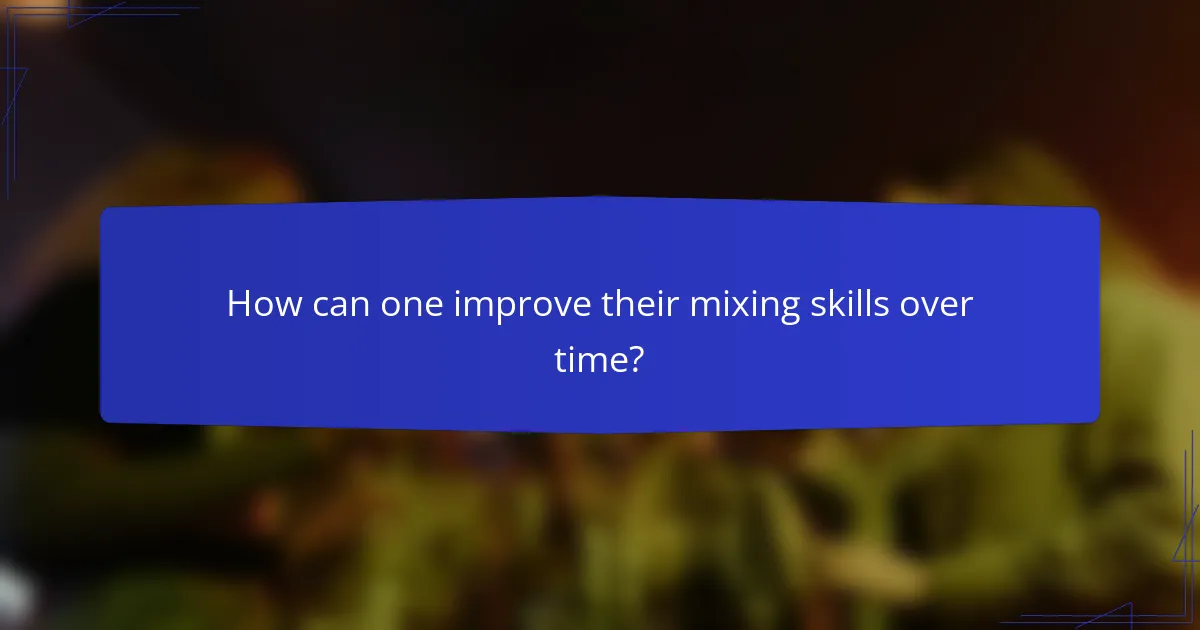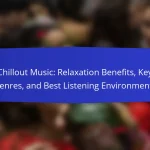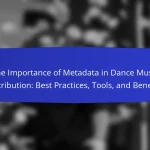The article focuses on the art of mixing dance tracks, emphasizing the techniques, tools, and best practices essential for creating a cohesive sound. Key concepts include the importance of rhythm, melody, and harmony, along with the application of audio mixing techniques such as EQ, compression, and reverb to enhance individual tracks. Best practices for effective mixing are outlined, including proper gain staging, dynamic control, and the use of panning and effects. Additionally, the article highlights the significance of regular practice, feedback, and learning from experienced mixers to improve mixing skills and maintain relevance in the evolving landscape of dance music production.

What is the Art of Mixing Dance Tracks?
The art of mixing dance tracks involves blending multiple audio elements to create a cohesive sound. This process requires an understanding of rhythm, melody, and harmony. Techniques such as EQ, compression, and reverb are commonly used to enhance individual tracks. The goal is to achieve balance and clarity in the mix. Effective mixing can elevate a dance track’s energy and emotional impact. Professional mixers often utilize digital audio workstations (DAWs) for precision. According to a study by the Journal of the Audio Engineering Society, skilled mixing significantly influences listener engagement. Therefore, mastering this art is crucial for successful dance music production.
How does mixing dance tracks differ from other music genres?
Mixing dance tracks differs from other music genres primarily due to its emphasis on rhythm and beat matching. Dance music often features a steady tempo, typically ranging from 120 to 130 BPM. This consistency allows for seamless transitions between tracks. Additionally, the use of electronic elements and samples is more prevalent in dance music. DJs often manipulate these elements to create unique soundscapes.
The structure of dance tracks usually adheres to a build-up and drop format. This is designed to energize the audience on the dance floor. In contrast, other genres may prioritize lyrical content or complex arrangements. Furthermore, the mixing techniques used in dance music often involve effects like reverb and delay to enhance the overall experience.
The goal of mixing dance tracks is to maintain a continuous flow of energy. This is essential for keeping the audience engaged. Other genres might focus more on storytelling or emotional expression, leading to different mixing priorities. Overall, the distinct characteristics of dance music shape its mixing approach significantly.
What are the key elements that define dance track mixing?
The key elements that define dance track mixing include balance, dynamics, EQ, and spatial effects. Balance ensures that all elements of the track can be heard clearly. Dynamics involve controlling the volume levels to maintain energy. EQ is crucial for carving out space for each sound, preventing frequency clashes. Spatial effects, such as reverb and delay, create depth and width in the mix. Additionally, transitions between sections should be smooth to maintain flow. Each of these elements contributes to a cohesive and engaging dance track.
Why is understanding genre-specific techniques important in mixing?
Understanding genre-specific techniques is crucial in mixing because it ensures the final sound aligns with audience expectations. Each music genre has distinct characteristics and production standards. For example, electronic dance music often emphasizes bass and kick drum prominence. In contrast, rock music may prioritize guitar clarity and vocal presence. Mixing techniques tailored to these genres enhance the overall listening experience. Research shows that genre familiarity influences listener satisfaction and engagement. According to a study published in the Journal of Music Technology and Education, genre-specific mixing improves track quality and listener retention. This highlights the importance of mastering techniques relevant to the specific genre being mixed.
What are the fundamental techniques used in mixing dance tracks?
The fundamental techniques used in mixing dance tracks include equalization, compression, reverb, and panning. Equalization adjusts the frequency balance of sounds. Compression controls the dynamic range, making quiet sounds louder and loud sounds quieter. Reverb adds depth and space, creating a sense of atmosphere. Panning positions sounds within the stereo field for a balanced mix. These techniques enhance clarity and cohesion in dance music. Effective use of these methods is essential for professional-quality mixes.
How do EQ and frequency management affect the mixing process?
EQ and frequency management are crucial in the mixing process. EQ, or equalization, adjusts the balance of different frequency ranges in audio tracks. Effective EQ helps to carve out space for each instrument. This prevents frequency masking, where sounds overlap and become indistinguishable. Frequency management involves controlling the overall spectrum of sound. It ensures that each element is heard clearly in the mix.
Using EQ, mixers can enhance or reduce specific frequencies. For example, boosting low frequencies can add warmth to bass instruments. Cutting mid frequencies can reduce muddiness in a mix. Frequency management allows for a more balanced sound. It creates a clearer listening experience. Proper use of EQ and frequency management leads to a professional-sounding mix.
What role does compression play in achieving a polished sound?
Compression reduces the dynamic range of audio signals, contributing to a polished sound. It evens out volume levels, making quieter sounds more audible and preventing louder sounds from overwhelming the mix. This process enhances clarity and presence in the overall sound. Compression also adds sustain to instruments and vocals, helping them blend seamlessly into the mix. By controlling peaks, it allows for a more consistent listening experience across various playback systems. Studies show that well-compressed tracks are perceived as more professional and engaging. Effective use of compression can significantly improve the emotional impact of a dance track.
How can reverb and delay enhance the mixing of dance tracks?
Reverb and delay enhance the mixing of dance tracks by adding depth and space. Reverb simulates the natural reflections of sound in a physical space. This effect creates a sense of ambiance, making the track feel larger. Delay, on the other hand, creates echoes that can fill gaps in the mix. It adds rhythmic interest and can create a sense of movement. Both effects can help blend elements together, making transitions smoother. Proper use of these effects can elevate the overall energy of the track. Studies show that well-implemented reverb and delay can significantly improve listener engagement in electronic music.
What tools are essential for mixing dance tracks effectively?
Essential tools for mixing dance tracks effectively include a digital audio workstation (DAW), audio interface, and studio monitors. A DAW allows for recording, editing, and arranging music. Popular DAWs like Ableton Live and Logic Pro are widely used in dance music production. An audio interface improves sound quality and provides connectivity for instruments and microphones. Studio monitors are crucial for accurate sound representation during mixing. Additionally, headphones are important for detailed listening in various environments. Plugins for equalization, compression, and reverb enhance the mixing process. These tools collectively enable producers to create polished and professional-sounding dance tracks.
What software is most commonly used for mixing dance music?
Ableton Live is the most commonly used software for mixing dance music. It is favored for its intuitive interface and powerful features. Many professional DJs and producers rely on Ableton Live for live performances and studio mixing. The software supports a range of audio formats and offers extensive MIDI capabilities. Its session view allows for flexible arrangement and improvisation. Additionally, Ableton Live includes a variety of built-in effects and instruments. This versatility makes it a top choice in the dance music genre. According to a survey by DJ TechTools, Ableton Live is used by over 50% of electronic music producers.
How do hardware tools complement digital mixing techniques?
Hardware tools enhance digital mixing techniques by providing tactile control and analog warmth. They allow for hands-on manipulation of sound, which can lead to more intuitive mixing decisions. Hardware tools such as mixers, equalizers, and compressors add depth and character to a mix. The analog components can produce richer harmonics compared to purely digital processing. Additionally, hardware tools can help reduce latency issues often found in digital environments. They also allow for real-time adjustments, making the mixing process more dynamic. Many professionals find that combining both hardware and digital tools results in a more polished final product. This hybrid approach is widely adopted in modern music production.
What plugins are considered must-haves for dance track mixing?
Essential plugins for dance track mixing include equalizers, compressors, and reverb. Equalizers allow precise control over frequency ranges. They help in shaping the sound of individual tracks. Compressors manage dynamics and ensure a balanced mix. They prevent peaks and maintain consistent levels. Reverb adds depth and space to the mix. It creates a sense of atmosphere in the track. Additionally, delay plugins can enhance rhythmic elements. Saturation plugins can add warmth and character. These tools are widely recognized in the music production community for their effectiveness in achieving polished dance tracks.

What best practices should be followed when mixing dance tracks?
To mix dance tracks effectively, follow these best practices: Start with proper gain staging to ensure levels are balanced. Use EQ to carve out space for each element in the mix. Apply compression to control dynamics and maintain energy. Utilize panning to create a sense of width and separation. Incorporate effects like reverb and delay sparingly to enhance depth. Regularly reference your mix on different speakers to ensure consistency. Lastly, take breaks to maintain fresh ears and perspective on your work. These practices help achieve a polished, professional sound in dance music.
How can one develop a mixing workflow for dance music?
To develop a mixing workflow for dance music, start by organizing your session. Create separate tracks for each element like drums, bass, and synths. Use a consistent naming convention for easy identification. Next, establish a balance by adjusting levels and panning. This ensures clarity in the mix.
Then, apply EQ to carve out space for each instrument. This helps prevent frequency clashes. Use compression to control dynamics and add punch. Consider adding effects like reverb and delay for depth.
Finally, reference your mix against professional tracks to gauge quality. This practice helps identify areas for improvement. Following these steps creates an efficient and effective mixing workflow for dance music.
What steps should be taken during the mixing process?
Begin by organizing all audio tracks. Ensure each element is labeled and categorized. Adjust levels for balance among all tracks. Apply EQ to enhance clarity and remove unwanted frequencies. Use compression to control dynamics and maintain consistency. Add effects like reverb or delay to create space. Pan instruments to create a stereo image. Finally, export the mix in the desired format for playback.
How does organization of tracks influence the mixing outcome?
The organization of tracks significantly influences the mixing outcome. Properly organized tracks allow for easier access to individual elements during the mixing process. This facilitates more efficient adjustments, such as volume levels, panning, and effects. When tracks are labeled and grouped logically, it reduces confusion and enhances workflow. For instance, grouping similar instruments can help maintain a cohesive sound. Additionally, organized tracks enable better automation and editing capabilities. A study by the Berklee College of Music highlights that structured sessions lead to higher quality mixes. Therefore, track organization is crucial for achieving a polished final product.
What common mistakes should be avoided in dance track mixing?
Common mistakes to avoid in dance track mixing include neglecting proper gain staging. Gain staging ensures that levels are optimized throughout the mixing process. Over-compression is another mistake, as it can squash dynamics and reduce energy. Failing to use reference tracks can lead to poor mixing decisions. Ignoring the importance of EQ can result in a muddy mix. Not panning elements correctly may cause a lack of space in the mix. Additionally, overlooking the role of reverb can make the track sound flat. Lastly, skipping the final listening test on various systems can miss critical issues.
How can over-compression impact the quality of a mix?
Over-compression can negatively impact the quality of a mix by reducing dynamic range. This results in a flat sound where individual elements lose their character. Instruments may blend together, causing a lack of clarity. Vocals can become buried in the mix, making them difficult to understand. Over-compression can also introduce unwanted artifacts, such as pumping or breathing effects. These artifacts can distract listeners and detract from the overall experience. According to the American Audio Engineering Society, maintaining a balanced dynamic range is crucial for a professional mix.
What are the risks of neglecting proper gain staging?
Neglecting proper gain staging can lead to significant audio quality issues. Clipping occurs when levels exceed the maximum, causing distortion. This distortion compromises clarity and fidelity in the mix. Poor gain staging can also result in a lack of dynamic range. A mix may sound flat or lifeless without proper level management. Additionally, it can introduce noise and unwanted artifacts. These issues can make the final product less professional. Proper gain staging ensures a clean signal path and optimal mixing conditions.

How can one improve their mixing skills over time?
To improve mixing skills over time, one should practice regularly and seek feedback. Consistent practice helps in developing a better ear for sound. Experimenting with different genres can enhance versatility. Learning from experienced mixers through tutorials or workshops provides valuable insights. Analyzing professional tracks helps in understanding mixing techniques. Utilizing digital audio workstations (DAWs) effectively is crucial for skill enhancement. Investing in quality headphones or monitors can improve sound quality perception. Finally, staying updated with mixing trends and techniques ensures continuous growth in skills.
What resources are available for learning more about mixing techniques?
Books on mixing techniques include “Mixing Secrets for the Small Studio” by Mike Senior. This book provides practical advice and techniques for mixing music effectively. Online courses on platforms like Coursera and Udemy offer structured learning on mixing techniques. These courses often include video tutorials and hands-on projects. YouTube channels such as Produce Like A Pro and Point Blank Music School feature free content on mixing techniques. Additionally, forums like Gearslutz and Reddit’s r/audioengineering provide community support and shared knowledge. Finally, software manuals for DAWs like Ableton Live and Logic Pro include detailed sections on mixing techniques specific to their platforms.
How can feedback from peers enhance mixing skills?
Feedback from peers can significantly enhance mixing skills by providing diverse perspectives and constructive criticism. Peers can identify areas for improvement that the mixer might overlook. This external input fosters a collaborative learning environment. It encourages experimentation with different techniques and tools. Additionally, receiving feedback can boost confidence in decision-making. Engaging with peers also promotes accountability in the mixing process. Studies show that collaborative practices lead to skill enhancement. For example, a study by Hattie & Timperley (2007) emphasizes the importance of feedback in learning. This evidence supports the idea that peer feedback is a vital component in developing effective mixing skills.
What are some practical tips for mixing dance tracks effectively?
Use EQ to carve out space for each element in the mix. This helps prevent frequency clashes. Utilize compression to control dynamics and maintain energy. Apply reverb and delay for depth and atmosphere. Ensure proper levels to achieve a balanced mix. Use reference tracks to guide your mixing decisions. Automate volume and effects for dynamic changes throughout the track. Finally, listen on different systems to ensure the mix translates well.
How can one maintain creativity while adhering to mixing standards?
To maintain creativity while adhering to mixing standards, one can experiment within established guidelines. Balancing personal style with technical requirements allows for innovative approaches. Utilizing unconventional techniques can enhance the mixing process. For example, applying effects in unexpected ways can create unique soundscapes. Additionally, integrating diverse genres can inspire fresh ideas while respecting mixing norms. Collaborating with other artists can also introduce new perspectives. These practices encourage originality without compromising quality. Ultimately, creativity thrives within a structured framework, allowing for both expression and professionalism.
What routines can help in refining mixing skills continuously?
Regular practice is essential for refining mixing skills continuously. Engaging in daily mixing sessions enhances familiarity with software and hardware tools. Setting specific goals for each session, such as improving EQ or compression techniques, fosters targeted development. Analyzing professional mixes helps to identify effective strategies and techniques. Seeking feedback from peers provides valuable insights for improvement. Participating in online mixing challenges encourages creativity and skill application. Recording and reviewing personal mixes allows for self-assessment and progress tracking. Finally, staying updated with industry trends and techniques through tutorials and workshops is crucial for ongoing skill enhancement.
The main entity of this article is the art of mixing dance tracks, which encompasses various techniques, tools, and best practices essential for creating high-quality dance music. The article explores the unique characteristics of dance music mixing, including the importance of rhythm, beat matching, and the use of electronic elements. Key elements such as balance, dynamics, EQ, and spatial effects are discussed, alongside fundamental techniques like compression and reverb. Additionally, the article highlights essential tools and software, common mistakes to avoid, and practical tips for refining mixing skills, emphasizing the significance of genre-specific techniques in achieving an engaging and polished final product.


